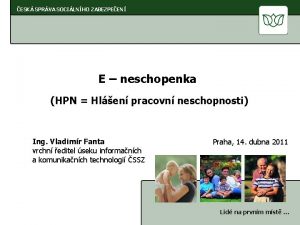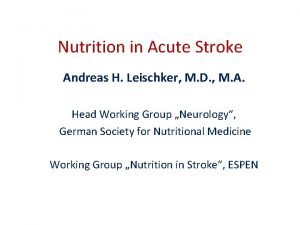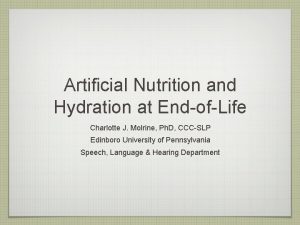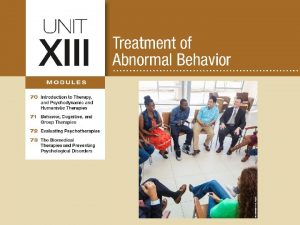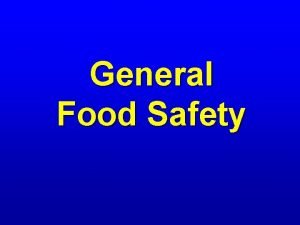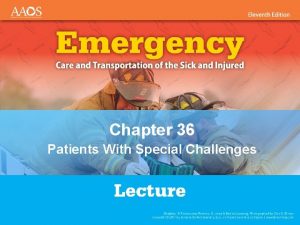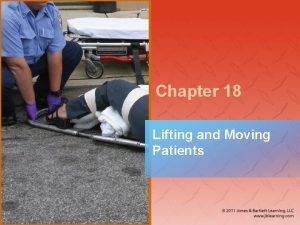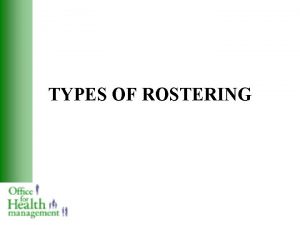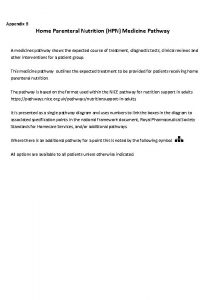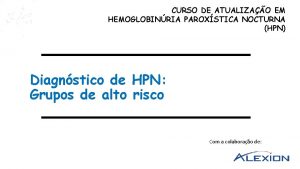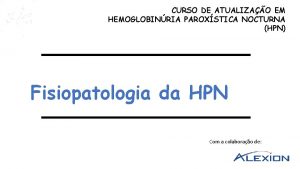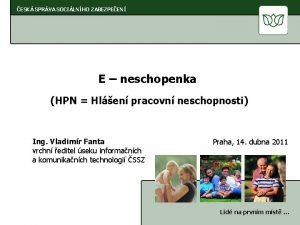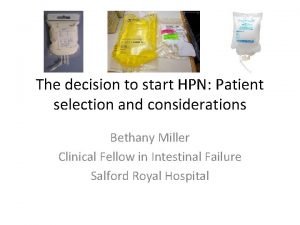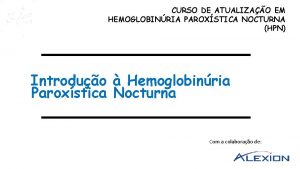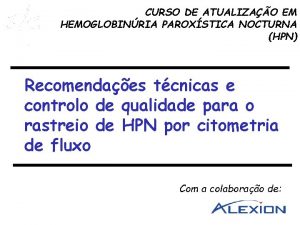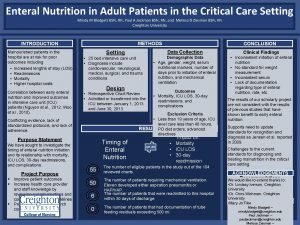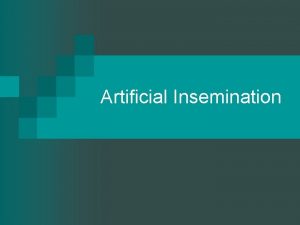Home Artificial Nutrition HPN in adult patients F

























- Slides: 25

Home Artificial Nutrition (HPN) in adult patients F. Bozzetti (Milano) B. Messing (Paris) M. Staun (Copenhague) A. Van Gossum (Brussels)

HPN in adult Content • Indications and Epidemiology • Venous access care • Metabolic complications: prevention and treatment • How to adapt nutritional support? • HPN in cancer patients • Training and monitoring

Home Artificial Nutrition (HPN) in adult patients Indications and Epidemiology A. Van Gossum (Brussels)

HPN in adult History (1) 1. HPN was initiated in North America (Shils et al) and in Western Europe (Solassol et al) in the early seventies 2. HPN programs started in specialized centres that rapidly developped a growing experience 3. At the beginning, HPN was exclusively reserved for patients with life-threatening intestinal failure related to benign diseases

HPN in adult History (2) 4. In the meantime, the number of HPN centres increased with a high variable number of patients from one to another centre 5. HPN has been progressively used in patients with intestinal failure related to advanced cancer (carcinomatosis) 6. HPN is now worldwide used in industrialized countries. However, legislations and funding are still lacking in many European countries

Intestinal failure Definition A condition in which the intestine is unable to process sufficient food to maintain an adequate nutritional state ( parenteral nutrition)

The central IV line was considered to be the "artificial gut"

HPN Underlying diseases • Benign: – Crohn's disease – mesenteric vascular disease – post-surgical, trauma – intestinal pseudo-obstruction – radiation enteritis – miscellaneous: chronic pancreatitis, mucosal atrophy, anorexia nervosa, … • Malignant • AIDS

HPN Causes • • Short bowel syndrome Digestive fistula Alteration of GI motility Chronic intestinal (pseudo-) obstruction (carcinomatosis) • Intractable diarrhea (AIDS) • Severe malnutrition

Short bowel syndrome Major resection of the small bowel Nutritional and metabolic consequences Diarrhea, fluid and electrolyte abnormalities, malabsorption, weight loss

Short bowel syndrome Parenteral nutrition-dependency Cut-off values of SB lengths • End-enterostomy (I) • Jejunocolonic (II) • Jejunoileocolonic (III) 100 cm 65 cm 30 cm Messing B, Transplant Proceedings, 1998

Jejuno-sigmoid anastomosis

Duodenostomy (Foley sonde)

Incidence of HPN from 1 January 97 to 31 December 97 ESPEN-HAN, Clin Nutr 1999, 18, 135

HPN in adult Incidence / Prevalence • The point prevalence of HPN is estimated to be 6 to 10 times higher in US than in Europe • Late available data: – Incidence: • 3/106 inhabitants/y France (2001 -2004) • 1. 65/106 inhabitants/y Spain (2001) – Point prevalence: • 12/106 inhabitants/y Scotland (2001) • 9/106 inhabitants/y UK (2001)

Point prevalence and new registrations of adults receiving HPN (UK) 1996 1997 1998 1999 2000 2001 2002 Point prevalence 207 250 306 344 400 422 465 New registrations 58 84 113 126 134 126 103 Number of reporting centres 21 28 29 25 28 28 34 BANS Registry, 2003

Distribution of underlying diseases for HPN patients in Europe (1997; n = 479) ESPEN-HAN, Clin Nutr 1999, 18, 135

Indications for HPN in 7 different European countries where reporting was assumed to be more than 80% of patients (1997) ESPEN-HAN, Clin Nutr 1999, 18, 135

Outcome at 1 January 1998 for HPN patients enrolled between 1 January 97 and 31 June 97 ESPEN-HAN, Clin Nutr 1999, 18, 135

HPN Complications 1. Catheter-related – sepsis – venous thrombosis – occlusion – migration 2. Metabolic • liver abnormalities • biliary stones • metabolic bone disease • trace element and/or vitamins deficiencies • manganese toxicity • renal function impairment 3. Psychological 4. Quality of life 5. Rehabilitation

Long-term HPN Complications (n = 228) • Hospitalization stays (within 12 previous months): 23 days (0 to 270 d) • Reasons for hospitalizations: – underlying diseases (37%) – HPN related (30%) (majority: catheter sepsis) – other (33%) ESPEN-HAN, Clin Nutr 2001, 30, 205

Long-term HPN Clinical features • n = 228 patients • Depression: 17% • Opiates use: 8% • Analgesics use: 35% • Interest for intestinal transplantation: 8% ESPEN-HAN, Clin Nutr 2001, 30, 205

Long-term HPN (n = 228) Rehabilitation status Before At HPN evaluation I Able to work full time 50% 35% or looking after home and family unaided II Able to work part time 14% 33% or looking after home and family with help III Unable to work but able 12% 23% to cope with HPN unaided and able to go out occasionally IV Housebound: needs major 24% 9% assistance ESPEN-HAN, Clin Nutr 2001, 30, 205

HPN – Indications and Epidemiology Conclusions (1) 1. HPN is worldwide used in industrialized countries 2. In many European countries as well as in US, cancer has become the main indication for HPN 3. For patients with benign diseases, the main indications are short bowel and chronic intestinal motility disorders

HPN – Indications and Epidemiology Conclusions (2) 4. The number of HPN centres increased with a variable degree of expertise 5. The prevalence in US is expected to be 10 times higher than in Europe (from 2 to 12/106 inhabitants) 6. HPN related complications are quite rare and rehabilitation status is good in the majority of the patients
 Hpn medical
Hpn medical Guideline clinical nutrition in patients with stroke
Guideline clinical nutrition in patients with stroke Pros and cons of artificial nutrition and hydration
Pros and cons of artificial nutrition and hydration Jr rabbin imam pretre
Jr rabbin imam pretre Perbedaan home care dan home service
Perbedaan home care dan home service Softly and tenderly jesus is calling
Softly and tenderly jesus is calling She said that, home economics stands for the ideal home.
She said that, home economics stands for the ideal home. Perbedaan home care dan home visit
Perbedaan home care dan home visit Oak springs mobile home park
Oak springs mobile home park Home sweet home survive crash
Home sweet home survive crash Mobile home parks for sale in sc
Mobile home parks for sale in sc Let's go to your house
Let's go to your house Plurals of flower
Plurals of flower Ethical issues in treating lgbt patients
Ethical issues in treating lgbt patients Non-infective
Non-infective Dr carlson advises his depressed patients
Dr carlson advises his depressed patients Food safety for immunocompromised patients
Food safety for immunocompromised patients Periodontal therapy in female patients
Periodontal therapy in female patients Safe staffing ratios benefiting nurses and patients
Safe staffing ratios benefiting nurses and patients What are the 7 patient rights?
What are the 7 patient rights? Position
Position Dealing with challenging patients
Dealing with challenging patients Tracheostomy stoma
Tracheostomy stoma Cataract care plan
Cataract care plan Ems lifting devices
Ems lifting devices Rostering patients
Rostering patients
